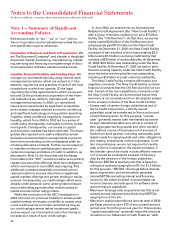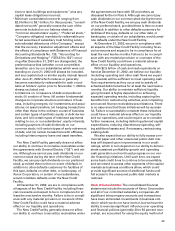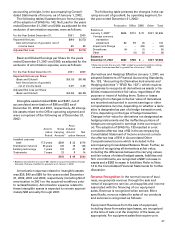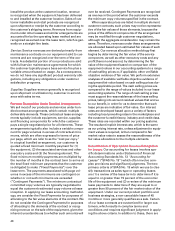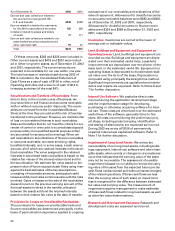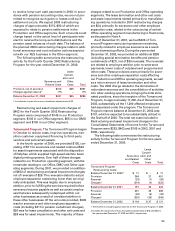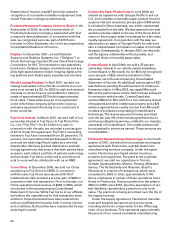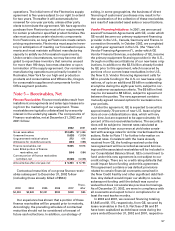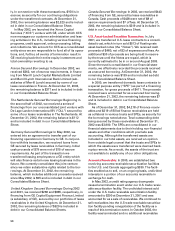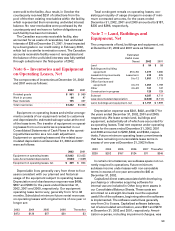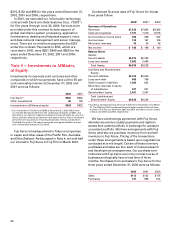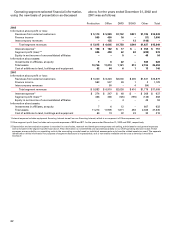Xerox 2002 Annual Report Download - page 54
Download and view the complete annual report
Please find page 54 of the 2002 Xerox annual report below. You can navigate through the pages in the report by either clicking on the pages listed below, or by using the keyword search tool below to find specific information within the annual report.
52
geographies to improve productivity and reduce
costs; and
• Integrating Xerox Engineering Systems (“XES”) into
our North American and European operations from
its previous stand-alone structure.
The severance and other employee separation
costs are related to the elimination of approximately
4,700 positions worldwide. Approximately 55 percent,
31 percent, 11 percent and 3 percent of the positions
related to the U.S., Europe, Latin America and
Canada, respectively. As of December 31, 2002,
approximately 1,700 of the 4,700 affected employees
had been separated under the program, and a majori-
ty of the remainder are expected to be separated in
the first quarter of 2003.
SFAS No. 146 requires recognition and measure-
ment of a liability for lease and other contract termi-
nation costs. For those lease contracts that are not
terminated, a liability must be recorded when the enti-
ty ceases using the leased property. This liability is
based on remaining rentals over the lease term, net of
estimated sublease rentals that can be reasonably
obtained for the property, regardless of whether the
entity intends to enter a sublease. The sublease rates
are based on estimated market rental rates. External
factors, such as appraisals, recent rental activities in
local markets, history of subleases in the same or sim-
ilar space and other factors are all considered when
estimating sublease rentals. Our estimated lease
costs of $45 for properties exited as part of the Fourth
Quarter 2002 Restructuring Program are net of future
sublease rentals of $19.
The lease termination and asset impairment charge
related primarily to the exiting and consolidation of
office facilities, distribution centers and warehouses
worldwide. The majority of the U.S. consolidation
resulted in a provision of $36, and was for facilities
located in California and other smaller locations.
The remaining provision of $9 related to the consoli-
dation of certain European facilities as a result of the
reduction in personnel. The Fourth Quarter 2002
Restructuring Program reserve balance at December
31, 2002 of $286 is expected to be substantially
utilized in 2003. As mentioned above, we recorded
$32 in special termination benefits and pension cur-
tailment charges representing enhanced retirement
benefits given to early retirees and the recognition
of previously unrecognized pension and other benefit
costs that will be paid to such employees. In addition
to these pension related costs, we also incur others
such as pension settlements. A pension settlement
occurs when we make lump-sum cash payments
to plan participants in exchange for their rights to
receive pension benefits in the future. We are
required to recognize a loss if, at the time of the settle-
ment, the assets attributable to those participants
included unrecognized losses. We expect that many
of the terminated employees will subsequently elect
in the Consolidated Statements of Income totaled $670,
$715 and $475 in 2002, 2001 and 2000, respectively.
The restructuring initiatives and a summary of the
impacts on our financial statements were as follows:
Restructuring Action Initiation of Plan
• Fourth Quarter 2002
Restructuring Program November 2002
• Turnaround Program October 2000
• SOHO Disengagement June 2001
• March 2000 Restructuring March 2000
Detailed information about each of the above
restructuring programs and the applicable accounting
rules we applied are outlined below.
Fourth Quarter 2002 Restructuring Program: As more
fully discussed in Note 1, on October 1, 2002, we adopt-
ed the provisions of SFAS No. 146. During the fourth
quarter of 2002, we announced a worldwide restructur-
ing program and subsequently recorded a provision
of $402. The fair value of the initial liability was deter-
mined by discounting the future cash outflows using
our credit-adjusted risk-free borrowing rate of 5.9 per-
cent. The provision consisted of $312 for severance and
related costs (including $32 for special termination
benefits and pension curtailment charges) and $45 of
costs associated with lease terminations and future
rental obligations, net of estimated future sublease
rents. We also recorded $45 for asset impairments
associated with the exit activities. Of the total asset
impairment charge, $32 relates to the recognition of
currency translation adjustment losses on our invest-
ment that were recognized in conjunction with the
shutdown of a foreign subsidiary. The remaining asset
impairment related to the write-off of leasehold
improvements in exited facilities. The total included in
Restructuring and asset impairment charges in the
Consolidated Statements of Income for the Fourth
Quarter 2002 Restructuring Program was $402.
Key initiatives of this restructuring include the
following:
• Streamlining manufacturing and administrative
operations;
• Transitioning to an indirect sales and service model
for our Office segment in Europe;
• Implementing an average 10 percent reduction in
the number of middle and upper managers across
all our businesses in the United States;
• Outsourcing work in areas not related to our core
business operations and where there is an economic
advantage. This includes the outsourcing of certain
service functions and moving towards an indirect
sales model where it was deemed cost beneficial to
do so.
• Implementing a wide-ranging series of initiatives
across Developing Markets Operations (“DMO”)


